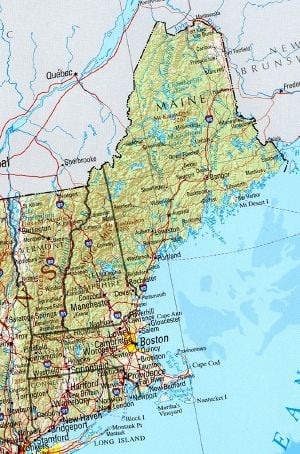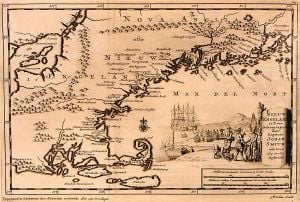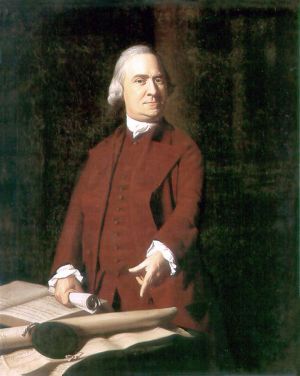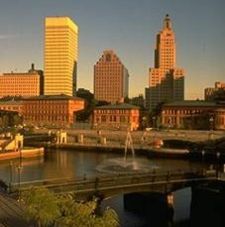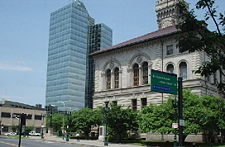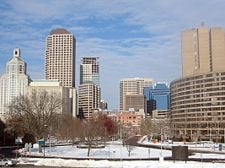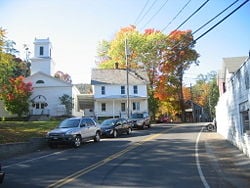New England
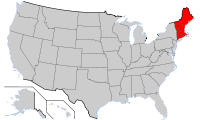 
| |
| Political history | |
|---|---|
| Chartering as Plymouth Council for New England |
1620-11-03[1] |
| Formation as United Colonies of New England |
1643 |
| Formation as Dominion of New England |
1686 |
| New York formally incorporated into the Dominion of New England |
1688-08-11[2] |
| As a result of the Glorious Revolution, Bostonians imprisoned the royal governor and others loyal to King James II, thereby ending the Dominion of New England. |
1689-04-18[3][4] |
| Regional statistics | |
| Largest city | Boston |
| U.S. States | Connecticut Maine Massachusetts New Hampshire Rhode Island Vermont |
| Area - Total |
71,991.8 sq mi (186,458.8 km²) |
| Population - Total (2006) - Density |
14,269,989[5] 198.2 people/sq mi (87.7 people/km²) |
New England is a region of the United States located in the northeastern corner of the country, comprised of Maine, New Hampshire, Vermont, Massachusetts, Rhode Island, and Connecticut.
In one of the earliest English settlements in the New World, English Pilgrims fleeing religious persecution in Europe first settled in New England in November 1620, establishing Plymouth Colony. In the mid-eighteenth century, the New England colonies became the first North American British colonies to demonstrate ambitions of independence.
In the nineteenth century, citizens of the region, along with those of the Seneca Falls Convention in New York, played a prominent role in the United States abolitionist movement. New England is the birthplace of distinctly American literature and the philosophy termed transcendentalism. It is considered home to the beginnings of public education and the first region of the United States to be transformed by the Industrial Revolution.
New England is the traditional center of ethnic English culture and ancestry in the United States.
Geography
New England's rolling hills, mountains, and jagged coastline are a consequence of retreating ice sheets. The coastline, extending from southwestern Connecticut to northeastern Maine, is dotted with lakes, hills, swamps, and sandy beaches. Further inland are the Appalachian Mountains, extending through Connecticut, Massachusetts, Vermont, New Hampshire, and Maine. Among them, in the White Mountains of New Hampshire is Mount Washington, which at 6,288 feet (1,917 m), is the highest peak in the northeastern United States. It is also the site of the highest recorded wind speed on Earth: during an April 1934 storm, a wind gust measured at 231 miles per hour (372 kilometers per hour) pushed across the summit of Mount Washington.[6] Vermont's Green Mountains, which become the Berkshires in western Massachusetts, are smaller than the White Mountains.
The longest river is the Connecticut River, which flows from northeastern New Hampshire for 407 miles (655 km), emptying into Long Island Sound. Lake Champlain, wedged between Vermont and New York, is the largest lake in the region.
Climate
Weather patterns are highly variable, and the climate varies throughout the region. Maine, New Hampshire, and Vermont have a humid continental short summer climate, with cooler summers and long, cold winters. Connecticut, Massachusetts, and Rhode Island have a humid continental long summer climate, with hot summers and cold winters. Owing to thick deciduous forests, fall in New England brings bright and colorful foliage, which comes earlier than in other regions, attracting tourists. Average rainfall generally ranges from 40 to 60 inches (1,000 to 1,500 mm) a year. Snowfall can often exceed 100 inches (2,500 mm) annually. As a result, the mountains of Vermont and New Hampshire are popular destinations in the winter, with numerous commercial ski resorts.[7]
History

New England's earliest inhabitants were Algonquian-speaking Native Americans including the Abenaki, the Penobscot, and the Wampanoag. Prior to the arrival of Europeans, the Western Abenakis inhabited New Hampshire and Vermont, as well as parts of Québec and western Maine. The Penobscot were settled along the Penobscot River in Maine. The Wampanoag occupied southeastern Massachusetts, Rhode Island, and the islands of Martha's Vineyard and Nantucket.
The Virginia Companies compete
On April 10, 1606, King James I of England issued two charters, one each for the Virginia Companies, of London and Plymouth, respectively.
These were privately funded proprietary ventures, the purpose of each being to claim land for England, trade, and return a profit. Competition between the two companies grew to where their potential New World territory overlapped and would be finalized based upon results.
The London Company was authorized to make settlements from North Carolina to New York, provided there was no conflict with the Plymouth Company’s charter.
The Popham Colony was planted by the Virginia Company of Plymouth. It was not initially successful and was abandoned after one year, though would later be revived. The Virginia Company of Plymouth's charter included land extending as far as present-day northern Maine. Captain John Smith, exploring the shores of the region in 1614, named the region "New England" in his account of two voyages there, published as A Description of New England.[8]
Plymouth Council for New England
The name "New England" was officially sanctioned on November 3, 1620, when the charter of the Virginia Company of Plymouth was replaced by a royal charter for the Plymouth Council for New England, a joint stock company established to colonize and govern the region.
The "first landing" of the Pilgrims, English religious separatists, was in Provincetown, Massachusetts, on November 21, 1620, and their signing of the Mayflower Compact took place there. Shortly afterward, in December 1620, a permanent settlement was established at present-day Plymouth. The Massachusetts Bay Colony, which would come to dominate the area, was established in 1628, with its major city of Boston established in 1630.
Banished from Massachusetts, Roger Williams led a group south and founded Providence, Rhode Island, in 1636. On March 3 of the same year, the Connecticut Colony was granted a charter and established its own government. At this time, Vermont was unsettled, and the territories of New Hampshire and Maine were governed by Massachusetts.
New England Confederation
In these early years, relationships between colonists and Native Americans alternated between peace and armed skirmishes. Six years after the bloodiest of these, the Pequot War, in 1643 the colonies of Massachusetts Bay, Plymouth, New Haven, and Connecticut joined together in a loose compact called the New England Confederation (officially "The United Colonies of New England"). The confederation was designed largely to coordinate mutual defense against possible wars with Native Americans, the Dutch in the New Netherland colony to the west, the Spanish in the south, and the French in New France to the north, as well as to assist in the return of runaway slaves. The confederation lost its influence when Massachusetts refused to commit itself to a war against the Dutch.
Dominion of New England
In 1686, King James II, concerned about the increasingly independent ways of the colonies, including their self-governing charters, open flouting of the Navigation Acts, and increasing military power, established the Dominion of New England, an administrative union comprising all of the New England colonies. On August 11, 1688, the provinces of New York and New Jersey, seized from the Dutch in 1664, were added. The union, imposed from the outside and contrary to the rooted democratic tradition of the region, was highly unpopular among the colonists.
After the Glorious Revolution in 1689, Bostonians imprisoned the Royal Governor and other sympathizers of King James II, thus ending the Dominion Of New England de facto. The charters of the colonies were significantly modified after this change in English politics, with the appointment of Royal Governors to nearly every colony. An uneasy tension existed between the Royal Governors, their officers, and the elected governing bodies of the colonies. The governors wanted unlimited authority, and the different layers of locally elected officials would often resist them. In most cases, the local town governments continued operating as self-governing bodies. This tension culminated in the American Revolution.
New England and political thought
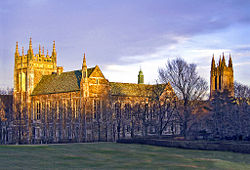
During the colonial period and the early years of the American republic, New England leaders like John Hancock, John Adams, and Samuel Adams joined those in Philadelphia and Virginia to assist and lead the newly forming country.
The colonies were now formally united as newly formed states in a larger (but not yet federalist) union, the United States of America. During the War of 1812, there was a limited amount of talk of secession from the Union, as New England merchants, just getting back on their feet, opposed the war with their greatest trading partner - Great Britain.[9]
For the remainder of the Antebellum period, New England remained distinct. Politically, it often went against the grain of the rest of the country. Massachusetts and Connecticut were among the last refuges of the Federalist Party. Many of the leading statesmen - including most prominently Daniel Webster - hailed from the region. New England was also distinct in other ways. It was, as a whole, the most urbanized part of the country (the 1860 census showed that 32 of the 100 largest cities in the country were in New England), as well as the most educated.
New England was also an early center of the industrial revolution. Towns like Lawrence and Lowell, Massachusetts, and Lewiston, Maine, became famed as centers of the textile industry.
New England and areas settled from New England, like Upstate New York, Ohio's Western Reserve and the Upper Midwest states of Michigan and Wisconsin, also proved to be the center of the strongest abolitionist sentiment in the country. Prominent abolitionists like William Lloyd Garrison and Wendell Phillips were New Englanders, and the region was also home to prominent anti-slavery politicians like John Quincy Adams, Charles Sumner, and John P. Hale. When the anti-slavery Republican Party was formed in the 1860s, all of New England, including areas that had previously been strongholds for both the Whig and the Democratic Parties, became strongly Republican (as it would remain until the early twentieth century, when immigration would begin to turn the formerly solidly Republican states of Lower New England toward the Democrats).
At the time of the American Civil War, New England, the mid-Atlantic, and the Midwest, which had long since abolished slavery, united against the Confederate States of America, ending the practice in the United States.
New England has largely preserved its regional character, especially in its historic places. Its name is a reminder of the past, as many of the original English-Americans have migrated farther west. Today, the region is more ethnically diverse, having seen waves of immigration from Ireland, Québec, Italy, Portugal, Asia, Latin America, Africa, other parts of the United States, and elsewhere. The enduring European influence can be seen in the region's heavy prevalence of English town and county names, and its unique, often non-rhotic coastal dialect reminiscent of southeastern England.
Population
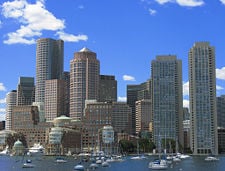
In 2000, the total population of New England was 13,922,517, roughly twice its 1910 population of 6,552,681.[10] Three-quarters of New England's population and most of its major cities are concentrated in its three southernmost states: Connecticut, Massachusetts, and Rhode Island. These three are among the four most densely populated states in the United States; only New Jersey has a higher population density. Their combined population density is 786.83/sq mi, compared to northern New England's 63.56/sq mi (2000 census). The most populous state is Massachusetts, and the most populous city is Massachusetts' political and cultural capital, Boston.
The coastline is more urban than western New England, which is typically rural, even in urban states like Massachusetts. This characteristic of the region's population is due mainly to historical factors; the original colonists settled mostly on the coastline of Massachusetts Bay. The only New England state without access to the Atlantic Ocean, Vermont, is also the least populated. New England's coast is dotted with urban centers.
The Boston metropolitan area had an estimated population of approximately 4.4 million in 2006.[11]
Economy
Several factors contributed to the unique New England economy. The region
- is geographically isolated from the rest of the United States and is relatively small
- has a climate and a supply of natural resources, such as granite, lobster, and codfish, that are different from other parts of the country
- has its population concentrated on the coast and in its southern states, and its residents have a strong regional identity.
- America's textile industry began along the Blackstone River with the Slater Mill at Pawtucket, Rhode Island, and was duplicated at similar sources of water power.
Exports consist mostly of industrial products, including specialized machines and weaponry, built by the region's educated workforce. About half the region's exports consist of industrial and commercial machinery, such as computers and electronic and electrical equipment. This, when combined with instruments, chemicals, and transportation equipment, makes up about three-quarters of the region's exports.
New England also exports food products, ranging from fish to lobster, cranberries, Maine potatoes, and maple syrup. The service industry is also highly important, including tourism, education, financial and insurance services, plus architectural, building, and construction services. Insurance is especially a driving force in and around Hartford, Connecticut.
As of May 2006, the unemployment rate in New England was 4.5 percent, below the national average. The highest was Rhode Island, with 5.5 percent.[12]
New England is home to two of the ten poorest cities (by percentage living below the poverty line) in the United States: the state capital cities of Providence, Rhode Island, and Hartford, Connecticut.[13] These cities have struggled as manufacturing, their traditional economic mainstay, has declined.
As of 2005, the inflation-adjusted combined GSPs of the six states of New England was $623.1 billion, with Massachusetts contributing the most and Vermont the least.[14]
Energy
The region is mostly very energy efficient compared to the country at large. Rhode Island has the lowest per capita energy consumption of any state. The six New England states collectively have the highest electricity costs in the nation.
Three of the six New England states are among the country's highest consumers of nuclear power: Vermont (first, 73.7 percent), Connecticut (fourth, 48.9 percent), and New Hampshire (sixth, 46 percent).[15]
Politics
Contemporary politics
The dominant party in New England has long been the Democratic Party. In every New England state, both legislative houses have a majority of Democratic representatives. In 2007, Democrats held half of New England's governor's positions: Maine, New Hampshire, and Massachusetts. While the governors of Connecticut, Vermont and Rhode Island were Republicans, the legislatures had veto-overriding Democratic super-majorities.[16]
Due to the liberal lean of the region, the state Republican parties and the elected Republican officials have been more politically and socially moderate than the national Republican Party. New Hampshire is the most conservative state in the region and, prior to the 2006 election, had the only Republican-controlled legislature in New England.
Town meetings
A derivative of meetings held by church elders, town meetings were and are an integral part of governance of many New England towns. At such meetings, any citizen of the town may discuss issues with other members of the community and vote on them. This is the strongest example of direct democracy in the United States today, and the form of dialogue has been adopted under certain circumstances elsewhere, most strongly in the states closest to the region, such as New York, New Jersey, and Pennsylvania.
Notable laws
New England abolished the death penalty for crimes like robbery and burglary in the nineteenth century, before much of the rest of the United States did. New Hampshire and Connecticut are the only New England states that allow capital punishment,[17] although New Hampshire has not held an execution since 1939. Connecticut held an execution in 2005, the first in New England since 1960.[18]
Vermont was the first state to allow civil unions between same sex couples, and Massachusetts was the first state to allow same-sex marriage. In 2005, Connecticut also began to allow civil unions. In 2008, some form of same-sex unions will be in all New England states except Rhode Island, though the state does recognize Massachusetts marriages for its residents.
Education
Colleges and universities
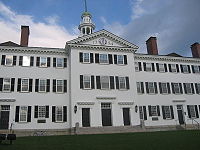
New England contains some of the oldest and most renowned institutions of higher learning in the United States. The first such institution, subsequently named Harvard College, was founded to train preachers, in 1636. Yale University was founded in 1701 and awarded the nation's first doctoral (Ph.D.) degree in 1861. Brown University, the first college in the nation to accept students of all religious affiliations and its seventh-oldest institution of higher learning, was founded in Providence, Rhode Island, in 1764. Dartmouth College was founded five years later with the mission of educating the local American Indian population as well as English youth. New England also contains the Massachusetts Institute of Technology (MIT).
Public education
New England states fund their public schools well, with expenditures per student, and teacher salaries above the national median. As of 2005, the National Education Association ranked Connecticut with the highest-paid teachers in the country. Massachusetts and Rhode Island ranked eighth and ninth, respectively. Every state but New Hampshire is in the top ten for educational spending per student. Boston Latin School is the oldest public high school in America. Several signers of the Declaration of Independence attended Boston Latin.
Culture
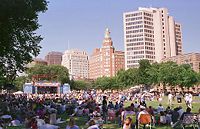
New England has a history of shared heritage and culture primarily shaped by waves of immigration from Europe. A cultural divide, however, also exists between urban New Englanders living along the densely populated coastline and rural New Englanders in western Massachusetts, northwestern Connecticut, Vermont, New Hampshire, and Maine.
The first European colonists of New England were focused on maritime affairs such as whaling and fishing. One of the older American regions, New England has developed a distinct cuisine, dialect, architecture, and government. New England cuisine is known for its emphasis on seafood and dairy; clam chowder, lobster, and other products of the sea are among some of the region's most popular foods.
In much of rural New England, particularly Maine, Acadian and Québécois culture dominate the region's music and dance. Contra dancing and country square dancing are popular throughout New England, usually backed by live Irish, Acadian, or other folk music. In some towns of Massachusetts, Rhode Island, and Connecticut, Portuguese music is preserved by Portuguese-American communities.
Literature
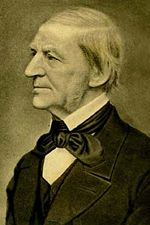
New England has been the birthplace of many American authors and poets. Ralph Waldo Emerson was born near Boston. Henry David Thoreau was born in Concord, Massachusetts, where he famously lived for some time by Walden Pond, on Emerson's land. Nathaniel Hawthorne was born in historical Salem; later, he would live in Concord at the same time as Emerson and Thoreau. Emily Dickinson lived most of her life in Amherst, Massachusetts. Henry Wadsworth Longfellow was from Portland, Maine. Noah Webster, the Father of American scholarship and education, was born in West Hartford, Connecticut.
The region has also drawn the attention of authors and poets from other parts of the United States. Mark Twain found Hartford, Connecticut, to be the most beautiful city in the United States and wrote his masterpieces there. He lived next to Harriett Beecher Stowe, whose most famous work is Uncle Tom's Cabin. John Updike, originally from Pennsylvania, eventually moved to Ipswich, Massachusetts, which served as the model for the fictional New England town of Tarbox in his 1968 novel Couples. Robert Frost was born in California but moved to Massachusetts during his teen years; his frequent use of New England settings and themes ensured that he would be associated with the region. Herman Melville, originally from New York City, wrote his greatest novel Moby-Dick in Pittsfield, Massachusetts.
Recreation
The Northern Appalachian Mountains run through New England, which make for excellent skiing. Southern Vermont, New Hampshire, and Maine are home to various ski resorts. There are nearly 100 established ski resorts across each of the six states in New England. While Rhode Island has only one, Yawgoo Valley near Exeter; Vermont and New Hampshire each offer as many as two dozen established skiing locations.
The coastal New England states are home to many oceanfront beaches. Connecticut's and Rhode Island's seacoast and Cape Cod, Nantucket, and Martha's Vineyard in Massachusetts are popular tourist destinations. Connecticut, Rhode Island, Massachusetts, New Hampshire, and Maine are all well known for their small-town charm and beaches.
In New England and off the east coast of Long Island, the whale watching attracts tourists from around the world. The season typically takes place from about mid-spring through early fall, depending both on weather and precise location. It is here that the Northern Humpback Whale, Fin Whale, Minke Whale, and the protected North Atlantic Right Whale are often observed. Areas like the Gulf of Maine and Stellwagen Bank National Marine Sanctuary (part of the inner waters formed by Cape Cod's hooked shape) have been important feeding grounds for whales. Due to the frequent visits of these mammals, a very large amount of research on large cetaceans takes place, in particular Woods Hole Oceanographic Institute.
Acadia National Park, off the coast of Maine, preserves most of Mount Desert Island and includes mountains, an ocean shoreline, woodlands, and lakes.
Notes
- ↑ William F. Swindler, (ed.) Sources and Documents of United States Constitutions. 10 Volumes; (Dobbs Ferry, New York; Oceana Publications, 1973-1979), Volume 5: 16-26.
- ↑ E. B. O’Callaghan, (ed.) Documents Relative to the Colonial History of the State of New York, Volumes 1 - 11. (Albany, NY: 1853-1887), Volume 3: 537
- ↑ Wesley Frank Craven. 1968. Colonies in Transition, 1660 – 1713. (New York, NY: Harper and Row), 224.
- ↑ Gerald E. Morris, and Richard D. Kelly, (eds.) 1976. Maine Bicentennial Atlas: An Historical Survey. Plate 11. (Portland, ME: Portland Historical Society).
- ↑ US Census Bureau. State & County QuickFacts Retrieved November 5, 2008.
- ↑ Mount Washington Observatory. The Story of the World Record Wind Retrieved November 5, 2008.
- ↑ Climate Change Research Center. A Climate Primer for New England Retrieved November 5, 2008.
- ↑ University of Nebraska-Lincoln. A Description of New England. Retrieved November 5, 2008.
- ↑ James Schouler. 1891. History of the United States vol 1. (New York: Dodd, Mead & Company.)
- ↑ Rhode Island Division of Planning. NEW ENGLAND POPULATION BY STATE: 1800 - 2000 Retrieved November 5, 2008.
- ↑ U.S. Census Bureau. Metropolitan and micropolitan statistical area population and estimated components of change: April 1, 2000 to July 1, 2006.
- ↑ U.S. Bureau of Labor Statistics. New England - Labor Force Statistics Retrieved November 5, 2008.
- ↑ US Census Bureau. May 2003. Poverty: 1999.
- ↑ Bureau of Economic Analysis. News Release: Gross Domestic Product (GDP) by State, 2005 Retrieved November 5, 2008.
- ↑ Sam Hemmingway. July 20, 2008. "Nukes by the numbers." Burlington Free Press.
- ↑ National Conference of State Legislatures. StateVote 2006 Retrieved November 5, 2008.
- ↑ Death Penalty Information Center. State by State Information Retrieved November 5, 2008.
- ↑ FOXNews.com. January 29, 2005. Supreme Court Lifts Order Blocking Connecticut Execution Retrieved November 5, 2008.
- ↑ YahooTravel. New Haven Travel Guide.
ReferencesISBN links support NWE through referral fees
- Adams, James Truslow. 1921. The founding of New England. Boston: Atlantic Monthly Press. Online edition.dinsdoc.com. Retrieved November 24, 2008.
- Adams, James Truslow. 1923. Revolutionary New England, 1691-1776. Boston: Atlantic monthly Press.
- Adams, James Truslow, and James Truslow Adams. 1926. New England in the republic, 1776-1850. Boston: Little, Brown.
- Andrews, Charles McLean. 1919. The fathers of New England; a chronicle of the Puritan commonwealths. (The Chronicles of America series, v. 6.) New Haven: Yale University Press.
- Axtell, James. 1973. The American people in colonial New England. (The American people.) West Haven, CT: Pendulum Press. ISBN 9780883010693
- Black, John Donald. 1950. The rural economy of New England: a regional study. Cambridge, MA: Harvard Univ. Pr. Online edition
- Brewer, Daniel Chauncey. 1926. The conquest of New England by the immigrant. New York & London: G.P. Putnam's sons.
- Conforti, Joseph A. 2001. Imagining New England: explorations of regional identity from the pilgrims to the mid-twentieth century. Chapel Hill: University of North Carolina Press. ISBN 9780807849378
- Craven, Wesley Frank. 1968. Colonies in Transition, 1660 – 1713. New York, NY: Harper and Row.
- Hemmingway, Sam. July 20, 2008. "Nukes by the numbers." Burlington Free Press.
- Karlsen, Carol F. 1987. The devil in the shape of a woman: witchcraft in colonial New England. New York: Norton. ISBN 9780393024784
- O’Callaghan, E.B. ed. Documents Relative to the Colonial History of the State of New York, Volumes 1 - 11. Albany, NY: 1853-1887, Volume 3: 537.
- Schouler, James. 1891. History of the United States vol 1. New York: Dodd, Mead & Company.
- Swindler, William F. ed. Sources and Documents of United States Constitutions. 10 Volumes; Dobbs Ferry, New York; Oceana Publications, 1973-1979, Volume 5
- Zimmerman, Joseph Francis. 1999. The New England town meeting: democracy in action. Westport, CT: Praeger. ISBN 9780275965235
External links
All links retrieved November 11, 2022.
- Yale Law School: Colonial Charters, Grants and Related Documents Avalon Project at Yale Law School.
- New England Music Archive
Credits
New World Encyclopedia writers and editors rewrote and completed the Wikipedia article in accordance with New World Encyclopedia standards. This article abides by terms of the Creative Commons CC-by-sa 3.0 License (CC-by-sa), which may be used and disseminated with proper attribution. Credit is due under the terms of this license that can reference both the New World Encyclopedia contributors and the selfless volunteer contributors of the Wikimedia Foundation. To cite this article click here for a list of acceptable citing formats.The history of earlier contributions by wikipedians is accessible to researchers here:
The history of this article since it was imported to New World Encyclopedia:
Note: Some restrictions may apply to use of individual images which are separately licensed.
